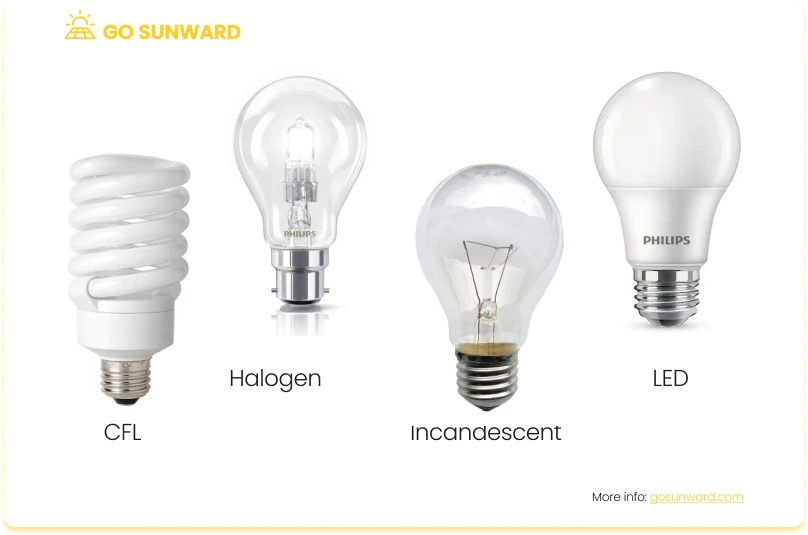What Are The Best Lights To Save Energy?
Embracing a sustainable lifestyle for your home can be remarkably simple, and one of the most impactful decisions you can make is adopting energy-efficient light bulbs. These everyday essentials not only contribute to reduced energy consumption but can also help lower your energy bills. With technological advancements, various lighting options offer various benefits beyond just illumination, which also don’t compromise style or functionality. This article delves into the world of energy-efficient lighting, discussing the best lights to save energy, their advantages for consumers regarding utility bills and the global shift towards net zero.
As you look to energy efficient sustainable solutions to adopt, we’re here to address some of the most pertinent questions that might arise along the way, including answering the question: ‘What are the best lights to save energy?’
How To Identify Energy-Efficient Light Bulbs?
Determining the energy efficiency of a light bulb is one of the first steps to answering ‘what are the best lights to save energy?’ And this can be achieved fairly easily by examining its packaging. Look for the ENERGY STAR® label, a government-backed symbol signalling energy efficiency.
In addition to the ENERGY STAR® label, check the packaging for information on the bulb’s wattage and lumens. Wattage indicates the amount of energy the bulb consumes, with lower wattage bulbs typically being more energy-efficient. Lumens, on the other hand, tell you how much light the bulb emits, allowing you to choose the right brightness for your needs.
For absolute energy efficiency, a light bulb would be able to convert all electricity into light without generating any heat. LED bulbs generally exhibit 90% efficiency, while CFL bulbs achieve an efficiency of 85%. In stark contrast, traditional incandescent bulbs stand at a mere 10% efficiency. Consequently, LED light bulbs have surged ahead as the contemporary standard, surpassing their counterparts for energy savings and proving the most popular.
Which Light Bulb Should I Use?
You have a variety of energy-efficient light bulb options to choose from, ranging from LEDs and CFLs to Halogens, catering to your specific lighting requirements and budget constraints. Most people trying to cut electricity costs go for LED lighting, you can find out if that is the right move here: are LED Lights energy saving?

1. LED Bulbs
When it comes to energy efficiency, LED (Light Emitting Diodes) bulbs are the ultimate choice, promising substantial reductions in electricity costs. Emitting between 40 to 80 lumens per watt, LEDs not only save energy but also boast very good longevity and luminosity. Their design uses minimal power but achieves high brightness levels, while also maintaining a comfortably low operating temperature.
The cost of LED light bulbs has been consistently decreasing since their introduction, and this trend is anticipated to persist as LED products become more widely accessible. Despite the initial higher price tag of LEDs than traditional incandescent bulbs, their economic advantages become apparent through their long-lasting performance and minimal energy usage. Consequently, users can enjoy substantial savings over time. Our research indicates that LED bulbs can endure anywhere from 25,000 to 50,000 hours or even more, a large contrast to the usual 1,000-hour lifespan of incandescent bulbs.
LEDs are semiconductor devices that emit light when an electric current passes through them. Unlike traditional incandescent or fluorescent bulbs, which produce light by heating a filament or exciting a gas, LEDs convert electrical energy directly into light through a process known as electroluminescence. For more details on exactly how LEDs work and the electroluminescence process behind the technology, click here.
2. CFL Bulbs
Compact Fluorescent Lamps (CFLs), while not as energy-efficient as LEDs, surpass the conventional incandescent bulbs in terms of efficiency. They offer an average lifespan of approximately 8,000 hours, a noticeable contrast from LEDs’ 25,000-hour plus lifespan. In practical terms, you’d need about three CFL bulbs to match the lifespan of a single LED.
Although CFL bulbs require a larger wattage to achieve the same brightness as LEDs, they still represent an energy-efficient choice. Operating a CFL bulb for 25,000 hours amounts to roughly $50, slightly pricier than LEDs. However, the initial cost of a CFL bulb is about half that of an LED, making it a more budget-friendly alternative over the short term.
CFLs work by exciting gas inside the bulb to produce ultraviolet light, which then interacts with the phosphorescent coating to emit visible light. While they contain a small amount of mercury, proper disposal and recycling can mitigate any potential environmental impact.
3. Halogen Incandescent Bulbs
Halogen incandescent bulbs employ a process similar to traditional incandescent bulbs. They generate light by heating a filament, typically made of tungsten, until it emits visible light. However, what sets them apart is the use of a small amount of halogen gas within the bulb. This gas helps to recycle the tungsten filament and prolong its lifespan.
Thanks to this gas, halogen bulbs often last 2,000 to 4,000 hours or more, reducing replacement frequency and costs. They’re also more energy-efficient than traditional bulbs, as the halogen gas enables higher filament temperatures, minimizing wasted heat and maximizing light output per watt.
While halogen incandescent bulbs are more energy-efficient than traditional incandescents, they are still less efficient compared to technologies like LEDs and CFLs
4. Smart Lighting Solutions
Advancements in smart lighting technology offer energy-saving capabilities by allowing users to control brightness and usage remotely. Smart bulbs can be programmed to adjust their brightness based on the time of day or occupancy, optimizing energy usage without sacrificing comfort.
Additionally, smart lighting systems often incorporate features such as motion sensors and ambient light sensors, further enhancing energy efficiency. Motion sensors detect when a room is empty and automatically turn off or dim the lights, preventing unnecessary energy consumption. Ambient light sensors adjust the brightness of the smart bulbs based on the natural light available in the room, ensuring that artificial lighting is used only when needed. These capabilities not only save energy but also contribute to a more sustainable and eco-friendly lighting solution.
5. Solar lighting
Learn more about solar energy here, you can now power all your lighting off solar and completely eliminate your lighting energy costs!
Conclusion
As we continue to transition to a more sustainable future, the choice of lighting plays a pivotal role in reducing energy consumption and reducing the environmental impact of energy consumption. LED lights, CFLs, halogen incandescent bulbs, and smart lighting solutions all contribute to this goal by offering enhanced energy efficiency, prolonged lifespans, and customizable options. By making informed decisions about lighting, individuals can not only save on energy bills but also contribute to individual and global sustainability goals.




